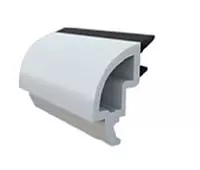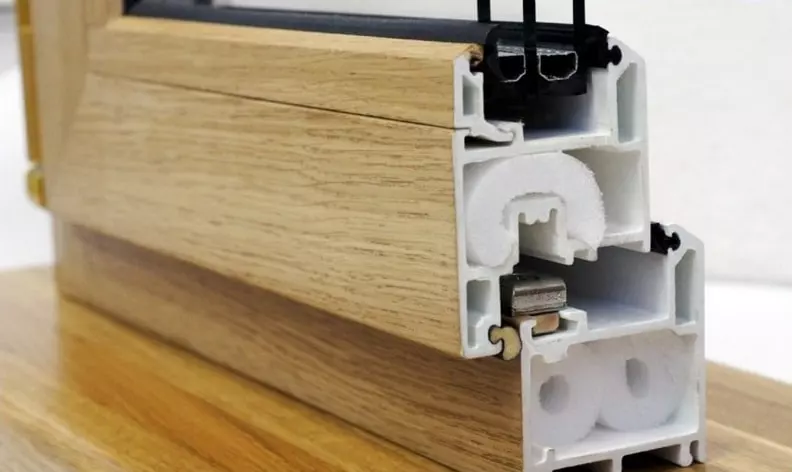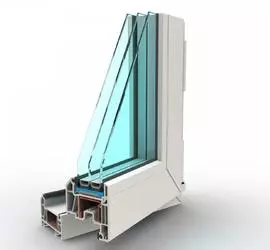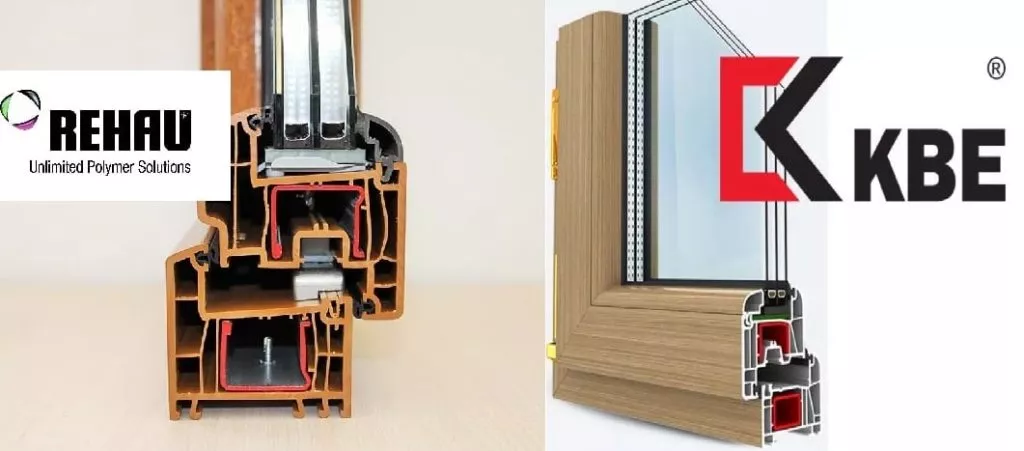|
A bead for plastic windows is a fastening element that holds the glass unit in the frame. It is a long strip made of PVC. To make the entire window structure airtight, this part is supplemented with a rubber gasket. It is located on the inside of the window along the entire perimeter of the glass. It is not on the outside so that intruders cannot remove the glass unit that is held in place by it. The bead is inserted into a special groove created in the PVC window specifically for it. Thanks to it, sound insulation is increased and a high degree of protection from street dampness and dust is achieved. |
 |
Types of glazing beads for windows
All types of glazing beads for plastic windows have a similar design; they are attached according to the same principle. The main differences are:
- sizes;
- form;
- material.
The sizes of beads depend on the characteristics of double-glazed windows for plastic windows. The width is maximum for those parts that hold a single glass. Beads intended for single-chamber double-glazed windows are considered typical. For two-chamber and three-chamber packages they are thinner; for four-chamber packages, reinforced versions are installed.
|
Rectangular |
Rounded |
Figured |
 |
 |
 |
Rectangular ones are the most common. They are installed in residential apartments, public buildings, and private houses. It is believed that their strength is the highest compared to other varieties. However, their acute corner is damaged more often than others, so it is often beveled.
Rounded glazing beads are often found in Rehau windows. This type is also very common; it is installed mainly in the glazing of residential apartments and houses. The rounded shape is more aesthetically pleasing, easier to care for, and less susceptible to deformation due to accidental impacts.
Curly glazing beads are the most aesthetic. They often serve as interior decoration, which is why they are chosen by owners of apartments designed in an unusual style, or owners of private houses. Due to their complexity, they require more careful handling and attention when caring, and they are easy to damage. But the attractive appearance makes up for all the inconveniences.
For ordinary plastic windows, the glazing beads are made of the same material – PVC. However, products made from fiberglass are now being distributed, which is close in strength to steel, but retains the flexibility of plastic. They usually come with fiberglass profiles.
What are wooden glazing beads?
|
In addition to plastic ones, there are also wooden glazing beads for windows. They are installed, respectively, on wooden frames. Visually, they do not differ from plastic ones, especially if the windows are not old, Soviet, but new, their shape is often rounded. They also perform the same functions – they hold the glass in the frame. However, wooden planks are less durable, they are not as moisture resistant, and are often attached to the frame with nails. |
 |
How to remove the glazing bead
Typically, removing the bead from a plastic window is necessary to wash or replace the glass unit. For owners of apartments located on the fifth floor or higher, washing windows while leaning out of the opening is quite dangerous; it is easier to remove the glass unit and wash it inside the room. Sometimes glass packages are changed from single-chamber to double-chamber or wider to reduce heating costs.
It will take about thirty minutes to remove the glazing beads. Depending on your skills, this time may be longer or shorter; professionals can handle this in a couple of minutes. If there are serious concerns, you can call the experts, for example, those who installed the plastic window. However, the work does not require special training; you can do it yourself. Before you start, it is better to soberly assess your strengths, estimate the feasibility of calling specialists and the price they will demand.
 To remove beads from plastic windows, you will need the following tools:
To remove beads from plastic windows, you will need the following tools:
- spatula, chisel or knife (most importantly, with a wide blade);
- hammer (ideally rubber);
- gloves.
This is the main set. Additionally, sheets of cardboard may be useful to put the removed glass unit on, markers, felt-tip pens or pencils to mark the glazing beads – this must be done before removing them from the plastic window, so as not to confuse them later, as well as fabric to cover nearby furniture for protection from accidental contamination.
If the sash is large, it will be difficult to hold the glass on your own, so you will need an assistant. So, to remove glazing beads from a plastic window, you need:
- Clear the window sill and clear the nearest space of unnecessary objects. It is better to cover the floor or table nearby with cardboard – it will protect the surface from sharp glass edges, and also protect the glass itself from scratches. It is not worth placing a double-glazed window on the end.
- Mark the glazing beads with something washable. It is better not to use permanent markers; they can be firmly absorbed into the plastic. It is impossible to confuse the planks, since they are made strictly to the dimensions of each side of the frame.
- Remember the removal order: first remove the side strips located vertically, then the bottom one. The top one is removed last. The side ones are the longest, and therefore flexible, making them easier to remove. The top one is pulled out at the end, since it holds the glass better than the others.
- Insert a spatula, chisel or knife (it is advisable to dull them first so as not to scratch the glass or damage the frame) between the glazing bead and the glass, starting from the middle. Ideally, start installation from the gap, if there is one. The tool is inserted at an angle, bending the bar. To help, you can gently tap the handle with a hammer or hand. You need to bend the spatula towards the glass until characteristic clicks appear with which the latches come out of the groove. When you can bend the middle, you can then remove the entire bar by hand.
- After removing the side parts, remove the bottom, then the top. At this stage, an assistant must support the glass unit.
- The removed glass is placed in the prepared place, washed, and cleared of sealant. The frame is also washed, the grooves are cleaned of dirt.
If the glazing bead is damaged, it can be cut to remove it. It makes more sense to order a new part from the company that installed the windows. Or you can measure the glass unit (this is done in the removed state), take the removed glazing bead and bring it to the store to get the same one. You won't be able to make it yourself.
How to install a bead
 To put the glazing bead in place in a plastic window, proceed in reverse order.
To put the glazing bead in place in a plastic window, proceed in reverse order.
- The frame is thoroughly cleaned of dirt and traces of old sealant, if used.
- The side of the glazing bead and its rubber gasket are lubricated with silicone grease for seals or Vaseline to increase durability and facilitate installation.
- A double-glazed window (new or washed old) is inserted into the window opening. Hold the bag with one hand, and insert the bead itself into the groove with the other, this is done while pressing the glass. Installation of glazing beads in plastic windows begins from the top part, from the corner. A glazing bead is inserted into the groove; if necessary, you can knock the bar with a hammer until it snaps into place. It is important to try to maintain a symmetrical position of all parts.
- Now the lower fastener is inserted. This is done in the same way: first – the corners, then by pressing or knocking with a hammer, the mustache is driven into the groove until it clicks.
- After the bottom planks, the side ones are installed.
- If necessary, the glass unit is sealed on the street side. To do this, tapes of masking tape are glued to the frame and glass along the joint at a distance of about 5 mm from each other. Silicone sealant is squeezed into the gap between the glass and the profile (usually from tubes using a gun), then it is evenly distributed with a finger dipped in a soap solution. When the composition dries, the masking tape peels off. The result is an even seam.
Sometimes, for additional protection from dust and contamination, a plug or false bead is inserted into the groove under the closed sash, located along the entire perimeter of the plastic window. Here this groove is not used, but dirt accumulates in it. The plug is a special seal that resembles a rubber cord. Usually it is simply pushed into the groove with a spatula and, if necessary, placed on glue. This makes window maintenance easier and makes it more aesthetically pleasing.
Advantages of plastic beads
 Bead strips made of PVC have the following advantages:
Bead strips made of PVC have the following advantages:
- Plastic. Plastic is flexible and at the same time resistant to fracture, so it deforms less during impacts than wood or aluminum. Due to its plasticity, it is easier to remove and insert PVC beads than those made of wood or metal. Due to this same property, replacing the glazing bead in a plastic window is very rarely necessary.
- Moisture resistance. Windows with plastic glazing beads do not absorb moisture; they resist street dampness. They can be installed in rooms with high humidity.
- Easy to install. You can remove and install plastic strips a large number of times. It doesn't require any special skills.
- Versatility. The design of all plastic glazing beads is similar; they are installed not only on windows, but also on balcony doors, panoramic glazing, transparent partitions, and other structures that include double-glazed windows.
- Resistance to temperature changes. Properties are maintained in the range from -60 to +60 degrees Celsius.
- Fire safety. PVC is a self-extinguishing polymer; it does not spread fire.
- Environmental Safety. Under sunlight, plastic does not emit harmful substances. The danger arises only with strong heating – an increase in temperature above 100-140 degrees leads to the decomposition of the substance with the release of carbon monoxide and hydrogen chloride.
- Resistance to microorganisms. PVC is not affected by bacteria or mold, the material does not contribute to their spread. It is also of no interest to pests.
- Unpretentiousness. The material can be easily cleaned with soapy water or glass detergents. Plastic is resistant to the concentration of alkalis, acids, and mineral oils found in household chemicals.
- UV resistance. High-quality plastic does not fade under sunlight.
- Availability. The price of plastic beads is quite low, it is lower than that of similar aluminum products, and is approximately equal to wooden slats.
- Decorative. Plastic slats look aesthetically pleasing, especially shaped or laminated options.
- Durability. Glazing beads last as long as the entire window – forty years or more.
To ensure that the benefits last longer, it is better to avoid high heat (above +60 degrees Celsius), exposure to esters, ketones and chlorinated hydrocarbons.
When do you need to replace the glazing bead?
 Due to their durability, you will have to replace glazing beads on a plastic window for the first time, subject to the rules of use, no earlier than the expiration of its service life. Usually this is several decades. However, replacement may be necessary earlier if the part has become deformed due to impacts or exposure to strong negative factors – fire, burglary attempts, etc.
Due to their durability, you will have to replace glazing beads on a plastic window for the first time, subject to the rules of use, no earlier than the expiration of its service life. Usually this is several decades. However, replacement may be necessary earlier if the part has become deformed due to impacts or exposure to strong negative factors – fire, burglary attempts, etc.
The product has to be replaced after the window has been improperly assembled. In order for the entire structure to be airtight, the glazing beads must strictly correspond to the dimensions, but sometimes they are a little shorter. As a result, cracks form in the corners, which quickly become clogged and untidy. Subsequently, drafts appear there and the tightness is lost.
Replacement is required if the glazing bead seal has dried out and lost its elasticity. In this case, the glass unit does not fit firmly to the frame and may dangle. The tightness is lost, drafts and noise appear, and dust flies into the house.
Another reason for replacement is the installation of a thicker or thinner glass unit, the width of which is different from the one that was installed previously.
To remove glazing beads for washing glass, replacing double-glazed windows or the slats themselves, it is not necessary to call a professional. Sometimes they even refuse to leave, since almost all housewives are capable of coping with the work. The main thing is caution and attentiveness, and if the window is large, another pair of hands.
Submit your application and find out
the cost of your window!




